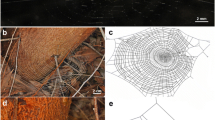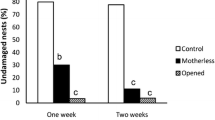Abstract
We describe oviposition and maternal behavior in the sawfly Cephalcia isshikiiand examine the adaptive significance of this behavior. Females deposited eggs in a single but loose cluster on needles of terminal twigs of spruces, Piceaspp., and remained with the eggs usually on the underside of the twig facing toward the tip. The female attended her eggs until death without taking food but did not follow the first-instar larvae that moved from natal needles even if she survived until then. When the female was disturbed, she usually moved toward the source and attempted to bite it. Though at much lower frequencies, this aggressive behavior was also observed in gravid females and even in males. Field observations and female removal experiments indicated that the female enhanced the survival of the eggs through the reduction of arthropod prédation.
Similar content being viewed by others
References
Carne, P. B. (1966). Primitive forms of social behaviour, and their significance in the ecology of gregarious insects.Proc. Ecol. Soc. Aust. 1: 75–78.
Clutton-Brock, T. H. (1991).The Evolution of Parental Care, Princeton University Press, Princeton, NJ.
Dias, B. F. de S. (1975). Comportamento pre-social de sinfitas do Brasil Central. I.Themos olfersii (Klug) (Hymenoptera: Argidae).Stud. Entomol. 18: 401–432.
Dias, B. F. de S. (1976). Comportamento pre-social de sinfitas do Brasil Central. II.Dielocerus diasi Smith, 1975 (Hymenoptera: Argidae).Stud. Entomol. 19: 461–501.
Eberhard, G. W. (1975). The ecology and behavior of a subsocial pentatomid bug and two scelionid wasps: Strategy and counterstrategy in a host and its parasites.Smithson. Contrib. Zool. 205: 1–39.
Eberhard, G. W. (1986). Possible mutualism between females of the subsocial membracidPolyglypta dispar (Homoptera).Behav. Ecol. Sociobiol. 19: 447–453.
Eickwort, G. C. (1981). Presocial insects. In Hermann, H. R. (ed.),Social insects, Vol. 2, Academic Press, New York, pp. 199–280.
Eidt, D. C. (1965). The life history of a web-spinning sawfly of spruce,Cephalcia fascipennis (Cresson) (Hymenoptera: Pamphiliidae).Can. Entomol. 97: 148–153.
Eidt, D. C. (1969). The life histories, distribution, and immature forms of the North American sawflies of the genusCephalcia (Hymenoptera: Pamphiliidae).Mem. Entomol. Soc. Can. 59: 1–56.
Evans, H. E. (1958). The evolution of social life in wasps.Proc. Int. Congr. Entomol., 10th, 1956, Vol.2, pp. 449–457.
Ghent, A. W. (1960). A study of the group-feeding behaviour of larvae of the jack pine sawfly,Neodiprion pratii banksianae Roh.Behaviour 16: 110–148.
Hassell, M. P. (1978).The Dynamics of Arthropod Predator-Prey Systems, Princeton University Press, Princeton, NJ.
Hinton, H. E. (1981).Biology of Insect Eggs, Pergamon Press, New York.
Ito, Y., and Miyashita, Y. (1968). BiologyHyphantria cunea Drury (Lepidoptera: Arctiidae) in Japan. V. Preliminary life tables and mortality data in urban areas.Res. Pop. Ecol. 10: 177–209.
Kudô, S., Satô, M., and Ôhara, M. (1989). Prolonged maternal care inElasmucha dorsalis (Heteroptera: Acanthosomatidae).J. Ethol. 75–81.
Maetô, K., and Yoshida, N. (1988). Characteristics of the oviposition of the red-headed spruce web-spinning sawfly,Cephalcia isshikii Takeuchi (Hymenoptera: Pamphiliidae).Appl. Entomol. Zool. 23: 361–362.
Maetô, K., Yoshida, N., and Akita, Y. (1987). Study on the spruce web-spinning sawfly,Cephalcia isshikii Takeuchi (Hymenoptera, Pamphiliidae). (I) Occurrence in 1986.Trans. Mtg. Hokkaido Br. Jap. For. Soc. 35: 82–84 (in Japanese).
Melber, A., Holscher, L., and Schmidt, G. H. (1980). Further studies on the social behaviour and its ecological significance inElasmucha grisea L. (Hem.-Het.: Acanthosomatidae).Zool. Anz. Jena 205: 27–38.
Michener, C. D. (1969). Comparative social behavior of bees.Annu. Rev. Entomol. 14: 299–342.
Nafus, D. M., and Schreiner, I. H. (1988). Parental care in a tropical nymphalid butterflyHypolimnas anomala. Anim. Behav.36: 1425–1431.
Nakamura, H. (1980). Ecological studies on the European pine sawfly,Neodiprion sertifer (Geoffroy) (Hymenoptera: Diprionidae). I. The effect of larval aggregation and its form.Jpn. J. Appl. Entomol. Zool. 24: 137–144 (in Japanese with English summary).
Nakamura, H. (1981). Ecological studies on the European pine sawfly,Neodiprion sertifer (Geoffroy) (Hymenoptera: Diprionidae). II. Relationship between the colony size and mortality rate or cause of the death in eggs and larvae.Jpn. J. Appl. Entomol. Zool. 25: 63–70 (in Japanese with English summary).
Nitto, M., Oda, K., and Kato, Y. (1955). On the life-history of the spruce saw-fly (Pamphiliidae) and the means of their control at Oneyama in Gumma Prefecture, central Honshu.Bull. Gov. For. Exp. Sta. 79: 15–42 (in Japanese with English summary).
Seymour, R. S. (1974). Convective and evaporative cooling in sawfly larvae.J. Insect Physiol. 20: 2447–2457.
Tallarny, D. W., and Denno, R. F. (1981). Maternal care inGargaphia solani (Hemiptera: Tingidae).Anim. Behav. 29: 771–778.
Tallamy, D. W., and Horton, L. A. (1990). Costs and benefits of the egg-dumping alternative inGargaphia lace bugs (Hemiptera: Tingidae).Anim. Behav. 39: 352–359.
Tostowaryk, W. (1972). The effects of prey defense on the functional response ofPodisus modestus (Hemiptera: Pentatomidae) to densities of the sawfliesNeodiprion swainei andN. pratti banksianae (Hymenoptera: Neodiprionidae).Can. Entomol. 104: 61–69.
Uchida, T., and Nishigawara, K. (1941). On a new pest of the spruce, the sawflyCephalcia isshikii. Hokkaido-ringyokaiho39: 287–297 (in Japanese).
Wilson, E. O. (1971).The Insect Societies, Harvard University Press, Cambridge, MA.
Windsor, D. M. (1987). Natural history of a subsocial tortoise beetle,Acromis sparsa Boheman (Chrysomelidae, Cassidinae) in Panama.Psyche 94: 127–150.
Winkler, D. W. (1987). A general model for parental care.Am. Nat. 130: 526–543.
Wood, T. K. (1976). Alarm behavior of brooding femaleUmbonia crassicomis (Homoptera: Membracidae).Ann. Entomol. Soc. Am. 69: 340–344.
Author information
Authors and Affiliations
Rights and permissions
About this article
Cite this article
Kudô, S.i., Maetô, K. & Ozaki, K. Maternal care in the red-headed spruce web-spinning sawfly,Cephalcia isshikii (Hymenoptera: Pamphiliidae). J Insect Behav 5, 783–795 (1992). https://doi.org/10.1007/BF01047987
Accepted:
Issue Date:
DOI: https://doi.org/10.1007/BF01047987




